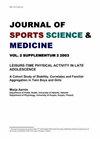最大偏心躯干伸肌运动对腰肌外结缔组织的影响:配对超声研究。
IF 2.4
2区 医学
Q2 SPORT SCIENCES
引用次数: 0
摘要
最近,有研究表明肌外结缔组织(ECT)可能参与迟发性肌肉酸痛(DOMS)。因此,本研究的目的是探讨最大躯干伸展偏心运动(EE)对ECT厚度、自述DOMS、ECT僵硬度、皮肤温度的影响,以及这些结果之间可能的相关性。健康成人(n = 16, 29.34±9.87岁)进行疲劳性躯干电休克。将高活动量组(TR, n = 8,每周运动14小时)与低活动量组(UTR, n = 8,每周运动< 2小时)进行比较。超声测量电痉挛的厚度,用MyotonPro和IndentoPro测量僵硬度,用红外热像仪测量皮肤温度,用触诊疼痛(100 mm视觉模拟量表,VAS)代替DOMS,记录电痉挛前(t0)、立即(t1)、24小时(t24)和48小时(t48)。术后ECT厚度从t0 ~ t24 (5.96 mm ~ 7.10 mm, p = 0.007)和从t0 ~ t48 (5.96 mm ~ 7.21 mm, p < 0.001)增加。VAS从t0到t24 (15.6 mm到23.8 mm, p < 0.001)和从t0到t48 (15.6 mm到22.8 mm, p < 0.001)也有所增加。皮肤温度从t1到t24(31.6°c到32.7°c, p = 0.032)和t1到t48(31.6°c到32.9°c, p = 0.003)有所增加,而硬度保持不变(p > 0.05)。相关分析显示48小时测量期间的结果之间没有线性关系。该结果可能证实了先前的发现,即ECT可能参与四肢迟发性肌肉酸痛的发生,也可用于干伸肌的棘旁ECT。后续的工作应该集中在针对ECT的可能干预措施上,以预防或减少剧烈肌肉EE后的DOMS。本文章由计算机程序翻译,如有差异,请以英文原文为准。
Effects of Maximal Eccentric Trunk Extensor Exercise on Lumbar Extramuscular Connective Tissue: A Matched-Pairs Ultrasound Study.
Recently, it has been shown that the extramuscular connective tissue (ECT) is likely involved in delayed onset muscle soreness (DOMS). Therefore, the aim of the present study was to investigate the effects of maximal trunk extension eccentric exercise (EE) on ECT thickness, self-reported DOMS, ECT stiffness, skin temperature, and possible correlations between these outcomes. Healthy adults (n = 16, 29.34 ± 9.87 years) performed fatiguing EE of the trunk. A group of highly active individuals (TR, n = 8, > 14 h of sport per week) was compared with a group of less active individuals (UTR, n = 8, < 2 h of sport per week). Ultrasound measurements of ECT thickness, stiffness with MyotonPro and IndentoPro, skin temperature with infrared thermography, and pain on palpation (100 mm visual analog scale, VAS) as a surrogate for DOMS were recorded before (t0), immediately (t1), 24 h (t24), and 48 h (t48) after EE. ECT thickness increased after EE from t0 to t24 (5.96 mm to 7.10 mm, p = 0.007) and from t0 to t48 (5.96 mm to 7.21 mm, p < 0.001). VAS also increased from t0 to t24 (15.6 mm to 23.8 mm, p < 0.001) and from t0 to t48 (15.6 mm to 22.8 mm, p < 0.001). Skin temperature increased from t1 to t24 (31.6° Celsius to 32.7° Celsius, p = 0.032) and t1 to t48 (31.6° Celsius to 32.9° Celsius, p = 0.003), while stiffness remained unchanged (p > 0.05). Correlation analysis revealed no linear relationship between the outcomes within the 48-hour measurement period. The results may confirm previous findings of possible ECT involvement in the genesis of DOMS in the extremities also for the paraspinal ECT of trunk extensors. Subsequent work should focus on possible interventions targeting the ECT to prevent or reduce DOMS after strenuous muscle EE.
求助全文
通过发布文献求助,成功后即可免费获取论文全文。
去求助
来源期刊
CiteScore
5.60
自引率
6.20%
发文量
56
审稿时长
4-8 weeks
期刊介绍:
The Journal of Sports Science and Medicine (JSSM) is a non-profit making scientific electronic journal, publishing research and review articles, together with case studies, in the fields of sports medicine and the exercise sciences. JSSM is published quarterly in March, June, September and December. JSSM also publishes editorials, a "letter to the editor" section, abstracts from international and national congresses, panel meetings, conferences and symposia, and can function as an open discussion forum on significant issues of current interest.

 求助内容:
求助内容: 应助结果提醒方式:
应助结果提醒方式:


